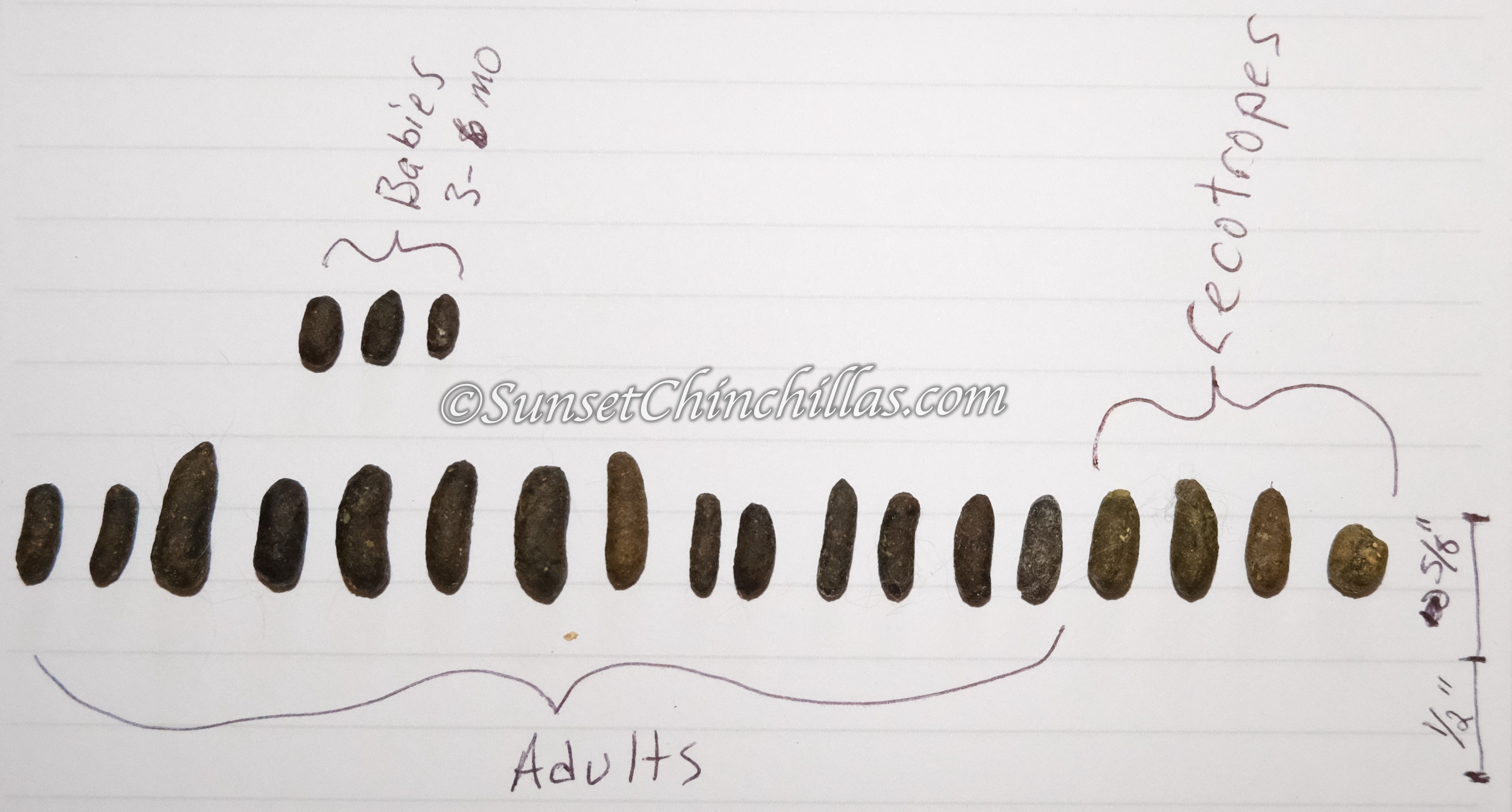Chinchilla excrement and Urine, things of note
Chinchilla fecal matter can vary in size from 1/4 inch to 1 inch long for a healthy adult regardless of body size. If you see something strange, just ask yourself what has changed. Weather? Household stress? Dietary changes* or Nothing noticeable?

Chinchillas are unique in that they can slow their gut motility and digestion in addition to liquid exhalate during periods of stress. This means they poop less and smaller and drink and urinate less. Their urine can condense into a very dark red or brown depending on what was eaten, appearing more like syrup than urine. (see article in footnotes)
As noted in the history of chinchillas they are designed to go long periods of time without food and water and when disturbed will hide and cease intake for a few days up to a week in extreme cases.

Urine on white paper from a show lineup. Different chinchillas have travelled different distances, some as many as 26 hours. The less they drink the darker the urine is. It can also appear red or dark if they have been eating a lot of dyed things or apple wood.

Pink poop from being fed an inappropriate dyed treat.

Bright green poop is a cecotrope. Chinchillas practice coprophagia and re-digest stools to extract further nutrients they missed the first time. Most often you don't see them as they are consumed while they are coming out but occasionally they will be startled for a period of time allowing you to view a few before consumption. In addition to allowing them to get fat on air it means that the poo can be used directly in flower beds and gardens just like with rabbits.
The downside to this ability is that they do not do well with carbs or sugars, this includes man-made sugars and even fructooligosaccharides which are undigestible to humans but can be utilized by chinchillas ultimately leading to conditions such as fatty liver, diabetes and heart failure (increased fat around vital organs).
When to Worry, Urine;
- When pee smells sweet and is sticky or full of crystals (diabetes/precursor to liver or kidney failure)
- When pee smells sour/bitter or infected (bladder, urinary tract infection or Pyometra if female)
- Black Pee or chunks of fresh or black/dried blood in pee (kidney or bladder stones)
- Underside and face covered in pee (UTI or in some older females pelvic floor or bladder muscle failure)
- When it stinks (giardia or bacterial infection)
- When it is liquid (Extreme GI upset, use fresh healthy chin poo or plain probiotics out of a capsule) DO NOT USE BENEBAC. It is full of bad sweeteners and causes just as much harm as good.
- When it is full of bubbles (seriously, what did your chin get into? Whatever it is go back to hay and pellets stat)
Common things that are annoying but not harmful - wet sticky poop that sticks to fur or flattens to shelves (but maintains shape). This is usually from excess water intake. Your chinchilla got hot, thirsty, had too many sweet things (apple/pear sticks!!) or just ate something that didn't agree. The fastest way to dry this up is throw a healthy chin's poop in there. If you do not have access to healthy chin poop the powder from a capsule of probiotics is fine. If you don't have that straight alfalfa will sometimes clear it up and rarely charcoal. It can take 2-5 days to clear up a case of wet poos, and more often than not it will go away on it's own when the cause is abated. I often find people put their chins against a wall that has a lot of heat coming off of it from the sun or an appliance and they will drink more due to this.
*A chinchillas diet consists of the food you use, hay if you use it and any wood or other items placed in the cage. They can not only digest wood and other organic materials but also absorb the limited nutrients out of it. This is what allows them to survive in their extreme mountain habitats in the wild.
Reference article; Energy Regulation and Thermoregulation in Chinchillas - Arturo Cortes, Carlos Tirado, Mario Rosenmann